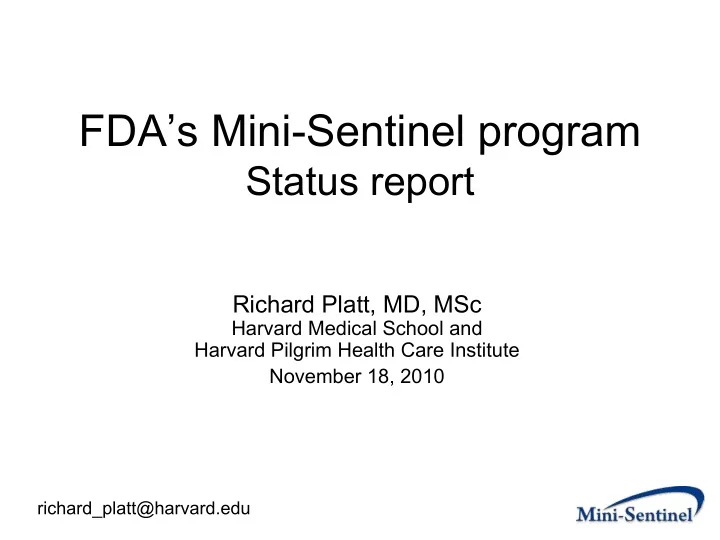

FDA’s Mini-Sentinel program Status report Richard Platt, MD, MSc Harvard Medical School and Harvard Pilgrim Health Care Institute November 18, 2010 richard_platt@harvard.edu
Deliverables* • Organizational model – Coordinating center, distributed data partners, content expertise • Principles and Policies • Data – Administrative, claims, EHR (inpatient, outpatient) – Query capability – Ability to link across sources • Methods development • Active surveillance – Ongoing evaluation of new products – One time evaluation of older products for which a question arises – Impact of FDA regulatory action * Five years
Coordinating Center
Distributed data partners
Additional Partners Institute for Health
Content expertise ~200, including: • All Vaccine Safety Datalink Principal Investigators • 12 AHRQ CERTs PIs • 9 AHRQ DEcIDE center PIs • 12 current/former FDA advisory committee members • 3 IOM “Future of Drug Safety” committee members • 4 International Society of Pharmacoepidemiology presidents • Critical Path Institute leadership
Principles/Policies • Public health practice, not research • Minimize transfer of protected health information and proprietary data • Data partners participate voluntarily • Maximize transparency • Public availability of “workproduct” – Tools, methods, protocols, computer programs – Findings • Confidentiality • Conflict of Interest for individuals
Data • Developed and implemented a Common Data Model • Created Mini-Sentinel Distributed Database v1, encompassing quality checked administrative and claims for 69 million individuals • Performed data inventory → prioritized list of data needs
Distributed Querying FDA MSCC 1a 1b Distributed Querying Portal 2 5 Data Partner Institutional Firewall / Policies Review & Run Review & Return Query Results 4 3 Local Datasets Common Data Model 1a- Query directly submitted by FDA to the Distributed Querying Portal 1b- Query submitted by MSCC to Distributed Querying Portal on behalf of FDA 2- Data Partners retrieve the query on the Distributed Querying Portal 3- Data partners review and run query 4- Data partners review results 5- Data partners return results to Distributed Querying Portal for review by FDA and\or MSCC
Active surveillance • Created framework for safety surveillance study designs and a prioritized list of gaps • Designed protocol for active surveillance of acute myocardial infarction following oral hypoglycemics • Designed protocol to validate acute myocardial infarction using full text records. – Implementation under way!
Methods development • Epidemiology methods – Literature review completed for algorithms to identify 20 outcomes using coded health data • Statistical methods (under way) – Better adjustment for confounding – Case based methods – Regression methods for sequential analysis
Communication www.minisentinel.org
Next steps – active surveillance • Drugs – Implement active surveillance protocol for acute MI related to oral hypoglycemics – Evaluate emerging safety issues for • New molecular entities (newly approved drugs) • Drugs that have been marketed for >2 years – Evaluate the impact of regulatory actions (e.g., restricted distribution) • Vaccines (PRISM) – Develop sustainable successor to ad hoc active surveillance system developed for H1N1 vaccine safety surveillance by HHS, FDA, & CDC – Institute safety monitoring for a vaccine – Link to state immunization registries – Identify complementary data sources
Next steps – data and methods • Data – Update distributed data set quarterly – Add blood pressure, height, weight, tobacco use – Add selected laboratory test results – Evaluate methods for obtaining EHR data • Methods – Test anonymous linkage between data partners – Develop additional statistical methods – Assess comparability of Mini-Sentinel data to national data sources
Recommend
More recommend